Rostrum, Västergatan 21, 211 21 Malmö, 040-30 18 16, öppet: lörd.-sönd. kl. 12-16 & onsd.-fred. 14-18
___________________________________
Artist in Residence 2010
__________________________________________
ARTIST IN RESIDENCE 2010
Galleri Rostrum driver projektet på initiativ av Tuss Marie Lysén i samarbete med Christel Lundberg
Projektet är tänkt som en serie Artist in Residence där konstnären, den kreativa arbetsprocessen och dess komplexitet står i fokus.
Genom att sammanföra bostad/ atelje/arbete med själva det fysiska utställnings/-rummet/-idén öppnar Galleri Rostrum upp för nya vägar och tankar kring konstnärliga arbetsprocesser.
Genom projektet vill vi skapa en mobil struktur som ger den konstnärliga integriteten och friheten högsta prioritet.
Projektledare AIR 2010:
Tuss Marie Lysén (konstnär Galleri Rostrum)
Christel Lundberg (konstnär Galleri Rostrum)
Artist in Residence 2010 är Jenny Yurshansky US Installation," Fruits of the Sea "
Artist in Residence 2011 är under uppbyggnad.
-------------------
-----------------
JENNY YURSHANSKY (US)
Artist in residence (18 juli - 20 augusti)
Utställning/Exhibition: 21 augusti -12 sept
Recension ARTIST IN RESIDENCE i Sydsvenskan. klicka här!/click here!
-----------------------------------
Galleri Rostrum presenterar stolt/proudly presents ARTIST IN RESIDENCE 2010
--------------------------
NYHETER/NEWS:
Vernissage Lördag 21 Aug/Opening Aug 21 kl 12 - 16
Välkomna! /Welcome!
JENNY YURSHANSKY (US)
Fruits of the Sea
21 Augusti – 12 September
--------------------------------
Further down a discussion between Jenny Yurshansky, artist in residence 2010, and Staffan Schmidt, fil.dr. K3, Malmö University
--------------------------------
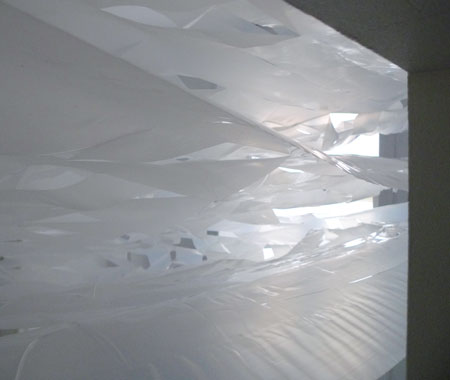
©2010, Jenny Yurshansky,Fruits of the Sea
English version further down
------------------------------
“Den kalifornienfödda konstnären Jenny Yurshansky tar i sin installation Fruits of the Sea med besökaren på plastens resa från oljan som naturresurs under havsbotten till skräpet på havsytan; olja som nyttighet och vardagsförenklare och dess undanträngda men oskiljbara baksida: stigande temperaturer, rykande plastberg och flytande plastöar.
Samtidigt är installationen ett sätt att återknyta till sin mormor, vars språk hon inte kunde förstå, men vars sparsamhet och ständigt pågående handarbete, sina pappersklipp och sömnadstekniker återkommer i Jenny Yurshanskys intresse för mönster och detaljer.
För Jenny Yurshansky överförs kunskap visuellt i en delande, kollektiv gemenskap, där man följer vad någon annan gör för att själv upprepa det. Men kunskap genom visualitet är ett tveeggat hjälpmedel. Det är inte svårt att göra det bekanta främmande och skapa distans genom en bild. Som den passiviserande bilden av skräp på avlägsna, oåtkomliga platser.
Installationen Fruits of the Sea har två delar, ett första mörklagt rum där en liten öppning i de svärtade fönstren fungerar som en kamera utan lins: himlen ovanför Västergatan framträder skugglik och främmandegjord. På väggen kan man också ana positionsangivelser för historiska oljeutsläpp. Det inre rummet blockeras av en genomskinlig plastväv, en ryssja som växer, skikt i skikt, från tak till golv.
Jenny Yurshansky har bearbetat rullar av svart och klar plast med nål och sax till ett slags pappersklipp. Genom det tidsödande handarbetet vinner plasten en sällsynt skönhet, men som material kan det inte separeras från det skräp som blåser längs med våra gator. Plast är skapad av en livsstil vi känner att vi har rätt till, men vars konsekvenser vi tar avstånd ifrån, som den förbrända oljan i atmosfären, som plastsoppan i världshaven.”
Staffan Schmidt, fil.dr. K3, Malmö Högskola
Välkommen till vernissage lördagen 21 augusti kl 12- 16
Konstnären kommer att vara på plats.
Utställningen pågår mellan 21 augusti och 12 september 2010.
Kommissarier: Tuss Marie Lysén och Christel Lundberg
----------------------------------------
“The American artist Jenny Yurshansky, with her installation Fruits of the Sea, takes the visitor on a plastic journey from the natural resources of oil under the seabed to the plastic debris floating on the sea’s surface. The clear utility of oil in the everyday is paired with its displaced but inseparable dark side: rising temperatures, fuming plastic mountains and liquid garbage.
The installation in one sense is a way to reconnect with her grandmother, whose language she could not understand, but whose frugality and ongoing needlework, paper cut outs, and sewing techniques led not so indirectly to Jenny Yurshansky’s interest in design and detail.
For Jenny Yurshansky knowledge is transferred into a shared, collective community, that is based in the visual, whereby one watches what others do in order to repeat it themselves. But knowledge based in the visual is a double-edged sword. It is not hard to make the known strange and to create distance through an image. As distant as the image of pervasive debris in remote, inaccessible places.
The installation Fruits of the Sea has two parts, the first is a darkened room where a small opening in the blackened windows functions like a camera without a lens; within, the projected sky appears as a shadowy and alien. On a sheet of black plastic, one can also faintly see the coordinates of world wide oil spills. The inner room is blocked by clear plastic sheeting, a hoop net, that expands in layers from ceiling to floor.
Jenny Yurshansky has processed rolls of black and clear plastic with a needle and scissors in a similar fashion to paper cut outs. The time consuming manual labor poured into the plastic achieves a rare beauty, but that material cannot be separated from the rubbish that blows along our streets. Plastics are intrinsically part of a lifestyle that we feel we are entitled to, but whose consequences we try to distance ourselves from; the oil burned in the atmosphere and the plastic soup in the oceans.”
Staffan Schmidt, fil.dr. K3, Malmö Högskola
Welcome to the Opening Aug 21 at 12–16 PM. The artist will be on site.
The exhibition runs between August 21, 2010 and September 12, 2010
Commissioners: Tuss Marie Lysén och Christel Lundberg
---------------------------
A discussion between Staffan Schmidt and Jenny Yurshansky, Malmö 20100808
Q: In your previous work I notice symbols of presence in past tense or indirect presence, such as display cabinets, or presence as imagination, such as people associating to the word “monster”, or presence as endless possible combinations of a pattern – symbols of separation and detachment, symbols deprived of a stable context. Would you say that you treat these symbols as “empty signs”?
JY: I am interested in erasure, and in negative space, that you know what you do not know, and that you are who you are not. I try to generate significance through things missing: missing a place to enter becomes a place to project. It is up to you what you see, but I am looking for the moments of shimmering, that is, the multi-faceted meaning and significance, something that amounts to withstanding multiple interpretations.
It’s about leaving a space open, a blank space to complete the sentence, making a blank space for the viewer.
I mean there is the risk of becoming too didactic or pedagogic, to state what is the “correct” way to make an interpretation... I am looking for a wider opening.
Q: But does not this quite general artistic attitude amount to watching things from the sideline, to claim that art is forever the utopian unfinished, and that the integrity of art demands that artists stay disengaged?
JY: When I did Closely Knit, people that came and joined the circle completed it, and that the piece reflected the people there, but also the space itself. Those who knew how to knit – I had just recently learned how to – and those who did not met. The transference of knowledge was visual, and not individual, it was about sharing, and how information is traded and repeated.
Q: This takes me to what I like to call “The Importance of Grannies” – the repercussions of a child sitting in a kitchen with an interested, senior relative.
JY: This is a personal area, and I don’t yet know how to translate it into critical language. There is a close link between my grandmother and me, even though her Russian, spoken with a heavy Romanian accent created a language barrier. I was watching what she was doing. She was always working with her hands, sewing, painstaking attention to details, obsessive working.
She wrote me letters on reused, thin wrapping material, which she worked to become paper cuts. My babushka survived the war thanks to her skilled embroidery, sewing, and the intense hand labor. Coming from a literate family, she wanted to learn a craft just as I wanted to work with my hands, she is in more than one way the reason for my existence.
Q: I can see the paper cuts in what you are working on right now. Could you tell me more about the installation Fruits of the Sea.
JY: Obviously it’s about plastics. Raw material from underneath the ocean floor, produces produce that goes back to the sea and ends up like floating waste islands on the ocean’s surface, not productive in any more. I was thinking of the constructed borders between what is understood as “outside” and what I feel entitled to in terms of easy living and consumption. There is much talk about a Globalized World in terms of information and logistics, but when it comes to resources, and repercussions, borders determine it, and it is not related to global effects.
There is a disturbing letting go of responsibility, an “I can do nothing” attitude that connect to the distance between images, pictures, of waste, of the consequences of the oil industry, and what we are ready to see around us. The camera obscura I am constructing show how easily the real world is turned into something distant, allowing the onlooker not to deal with it directly.
We live by a trade off: when the leak is stopped, and spill is no more visible, everyone forgets about the long-term ramifications and how impossibly expensive it was, and goes back wishing for an easy life again.
Med stöd av
Malmö stad
Tack till:
more info about the artist here!
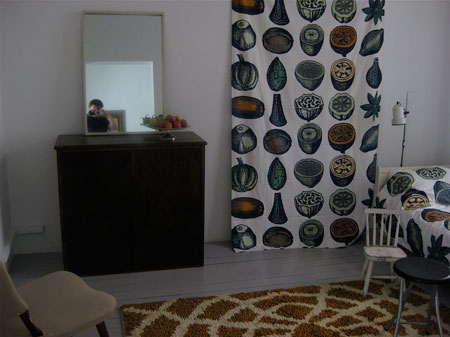
Artist in Residence Room, documentation: Jon Åkerlind
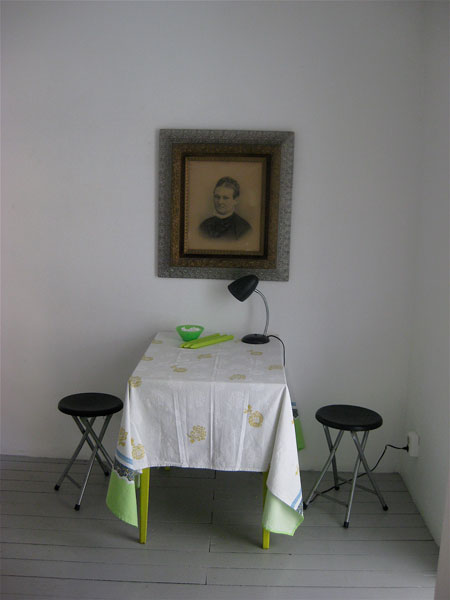
Artist in Residence Room, documentation: Jon Åkerlind
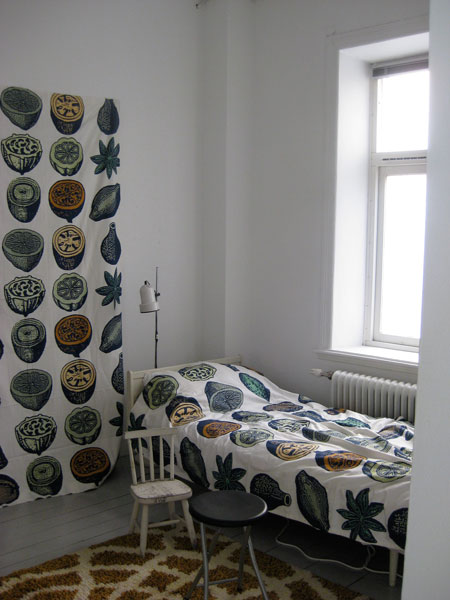
Artist in Residence Room, documentation: Jon Åkerlind
______________________________________________________________________________
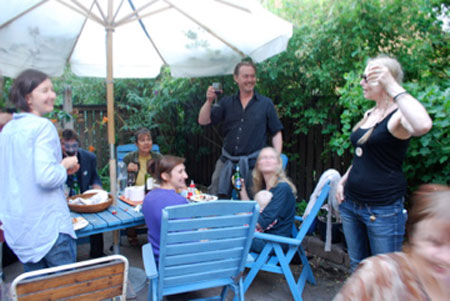
Barbequeing at Tuss beautiful backyard to welcome Jenny July 18

Vera Renella & Stefan Pöntinen music to welcome Jenny July 18
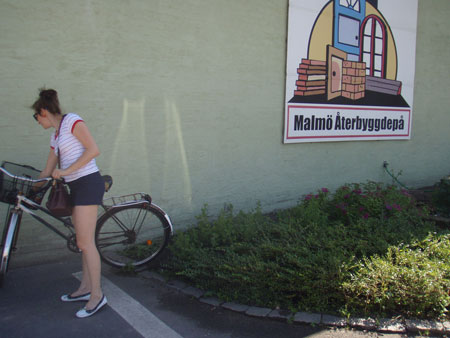
At Malmö Återbyggdepå to look for material July 20

Jenny with the new lock to the bike July 20
-------------------------
_______________________________________________________________________________
Se mer på Rostrums blog här!/For more info visit Rostrums blog!
